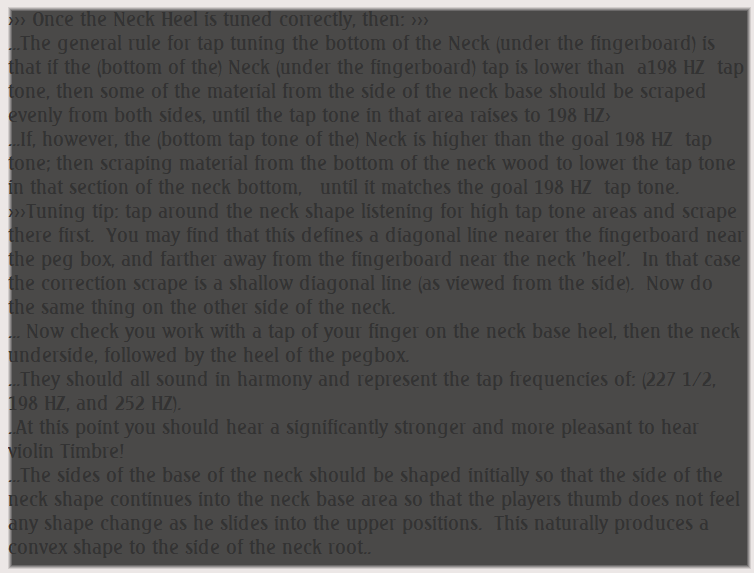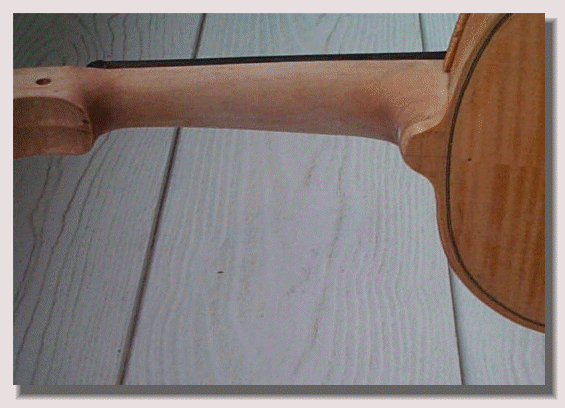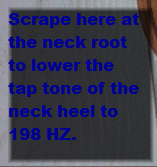...Scrape a more concave shape on the sides of the neck root to raise the heel tap tone to (242) HZ.
...Our goal is have an upward Tap Tone on the underside of the neck at 198 HZ, [While at the same time, the downward (from above) Tap Tone on the fingerboard's top surface will be: (227 1/2) HZ.]
..First: Tap Tone Tune the Heel of the neck here to (227 1/2) HZ (in harmony with the rib's tap tone of 227 1/2 HZ)
198 HZ
(revised 9/2021)
Page AA_36/_64
...The first part of this process is to tune the 'Heel' of the neck to (227 1/2) HZ (see specific instructions...) and THEN the underside of the neck, as follows.
*** If the (bottom of the) Neck (Heel) is lower than a (227 1/2) HZ tap tone, then the sides of the neck base should be scraped to a more concave shape, removing material evenly from both sides. (tap all along the sides and identify higher tap tone areas sand scrape those first.)
... If however, the (bottom of the) Neck Heel's tap tone is higher than the goal (227 1/2) HZ tap tone, then scraping material from the root of the neck will lower the tone until it reaches the (227 1/2) HZ goal.
...The tap tones of the underside of the violin neck play an important role in proper sound generation of your violin!
..I would go so far as to suggest that for each instrument, there is an ideal neck frequency where it plays up to its potential {for the adjustment for this aspect}. The amount of tone quality {Timbre} improvement is considerable when this tap tone frequency is achieved.
..Looked at from the side, the violin proper is a wooden spring counteracting the string tension spring effect, with the neck the main wood spring member. The two work against each other and counter balance each other; however, if the neck is too stiff, the violin body does not receive enough vibration motion. Conversely, if too weak, there is too much vibration motion transmitted to the violin body.
...Said a different way: If you make an excellent violin and leave the neck base a bit oversize (too stiff/ with too high neck tap tones) and string it up and play the instrument, note its performance and sound. And then begin to lower the tap tones by reshaping the neck base and then the under fingerboard neck shape ; play and listen again. And repeat over again in steps; I believe you will hear considerable change in performance, and at one specific shape (neck tap tones) the sound will be wonderful, at its peak, and the next change after that (lowering further the tap tones of the neck) will diminish the tone quality; which will continue to decrease as you move further from that ideal.
..My violin teacher and I performed just this acoustical experiment in his office. He would play my test violin and we would both listen. Then I would reshape the neck base, lowering the tap tone of neck frequency a small amount. He would play again. At one point, we both heard a large improvement in tone quality. He commented that 'I do not think you could do anything to make this violin play any better than this! The change was really amazing, it did not sound like the same violin. At the time I did not have the capability to accurately measure the frequency of the various violin parts, which would have allowed me to stop the experiment, measure all the parts for tap tones and only then continue with the experiment. However, not knowing, I continued to change the neck tap tone, as I was moving toward a specific goal tap tone relationship. When we got there is was not nearly as good as it had been.
..This story is just for illustration to the principle of an ideal neck frequency for a particular violin. It also suggests how rare an exceptional instrument really is; there are so many variables possible, and even a small change to just one of those can prevent the violin reaching its potential!



















